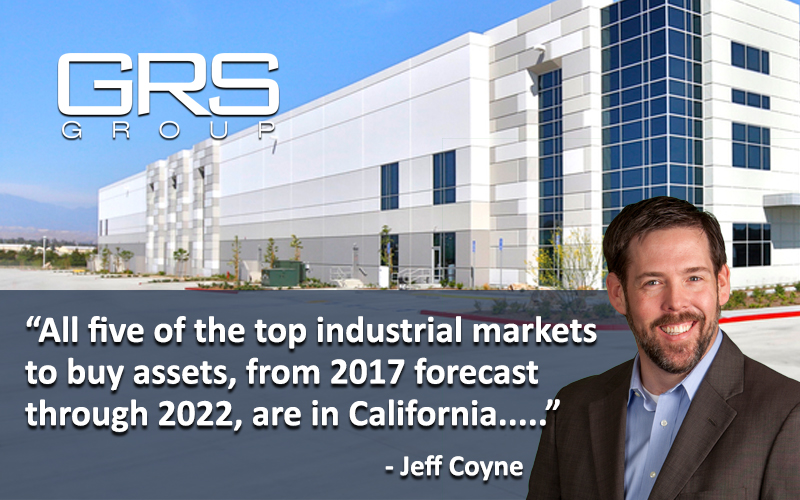
Jeff Coyne
Director, GRS Group
(510) 962-9534
[email protected]
Commercial real estate’s industrial sector is arguably the strongest in the industry right now, which has spurred major nationwide investment activity and falling capitalization rates, and it’s stronger in California than anywhere else in the United States, according to a recent report by Ten-X Commercial.
All five of the top industrial markets to buy assets, from 2017 forecast through 2022, are in California. Los Angeles is number one, followed by Sacramento, San Francisco, Oakland and San Jose. Despite being the most populous state, tech companies needing space for cloud computing and the growing marijuana industry are reportedly characteristics that solidify its leading status.
Rents per square foot in Los Angeles were at $6.94 last year and are forecast to hit $8.10 by 2022. Meanwhile, vacancy, at 2.4 percent, will remain relatively flat, at 2.8 percent. Sacramento’s rents were at $3.69 and are seen hitting $4.16, while vacancy should drop from 7.9 percent to 6.4 percent. Rents were $7.50 in San Francisco and are poised to reach $8.66, and vacancy will remain flat from 9 percent to 9.1 percent.
The country’s top “sell” markets all currently have strong economies, but industrial is not expected to flourish over the next few years. Cleveland, at the top of that list, could see rents dip from $4.58 to $4.60, and vacancy increase from 8.6 percent to 8.8 percent, due to a declining population that could lead to an economic slump. Slow-growing payrolls that could lead to an economic slump in suburban Maryland, despite being close to one of Amazon’s new HQ2 spots, with rents only rising from $7.71 to $8 and vacancy seen growing to 10.5 percent from 9.4 percent. Dallas, which was ranked number one in ULI’s Emerging Trends in Real Estate for 2019, is also expected to lag, with rents only rising from $4.45 to $4.50 and vacancy growing from 9.5 percent to 12.4 percent, due to it’s vast amount of new industrial development.
Overall this year, according to Ten-X, average overall U.S. pricing so far has been $85 per square foot, up from $80 in 2017. Year-over-year transaction volume has soared, increasing 21.5 percent for 2017’s first half, to $18.9 billion, while vacancies have decreased slightly. On the leasing end, there is more than 10 million square feet of absorption forecast for the fifth straight year.

